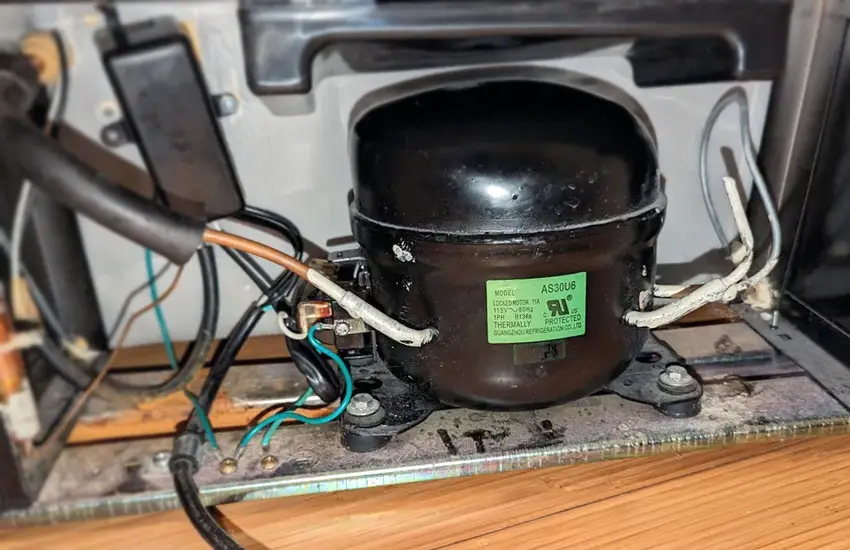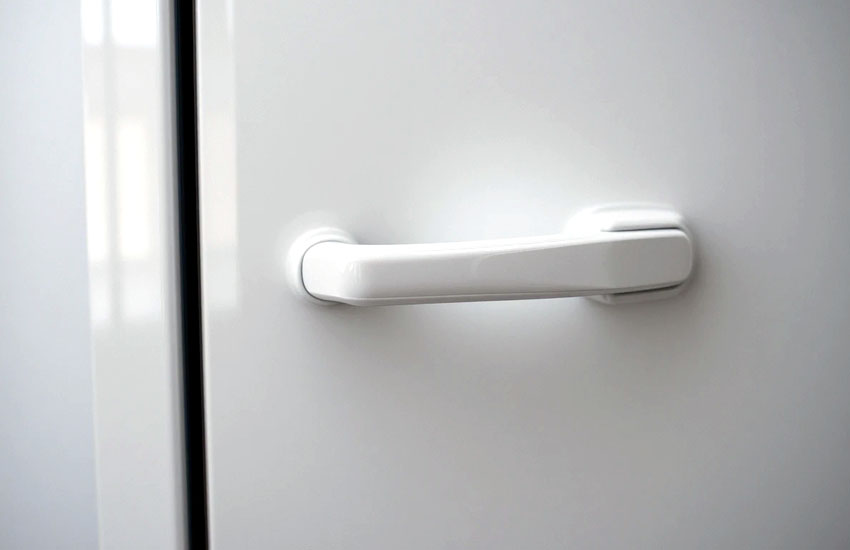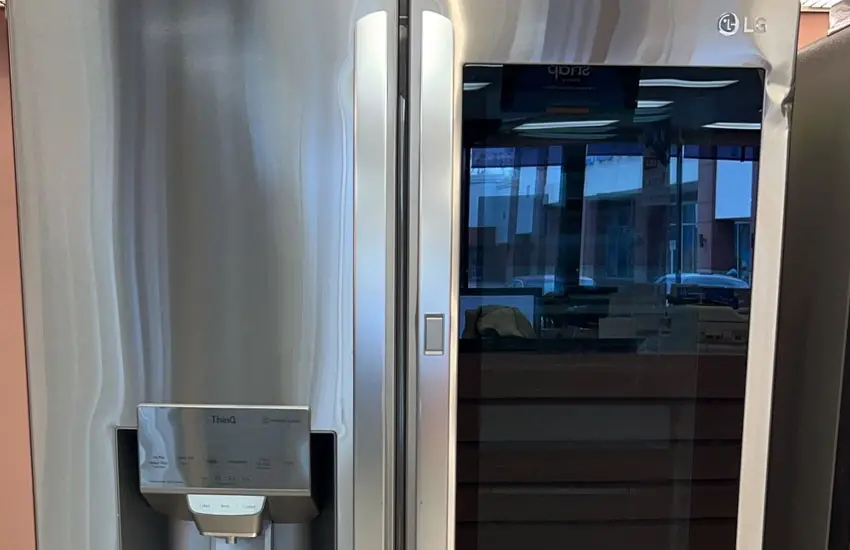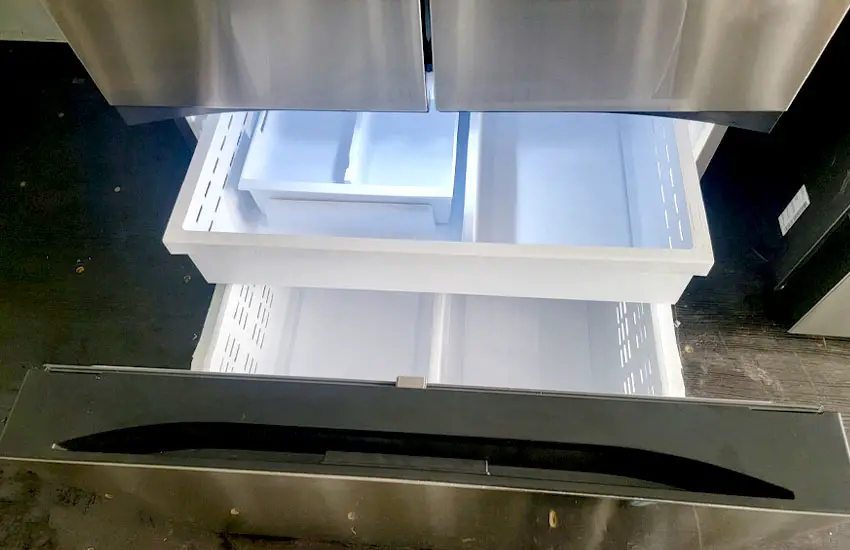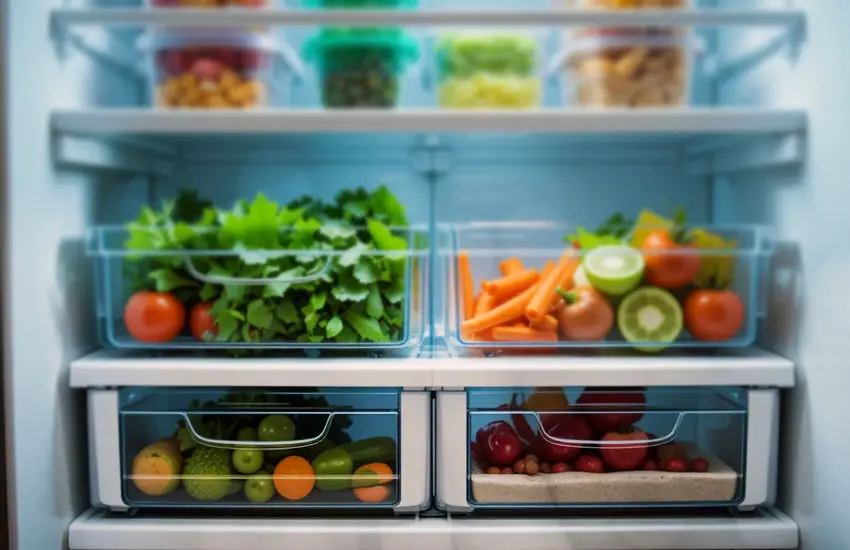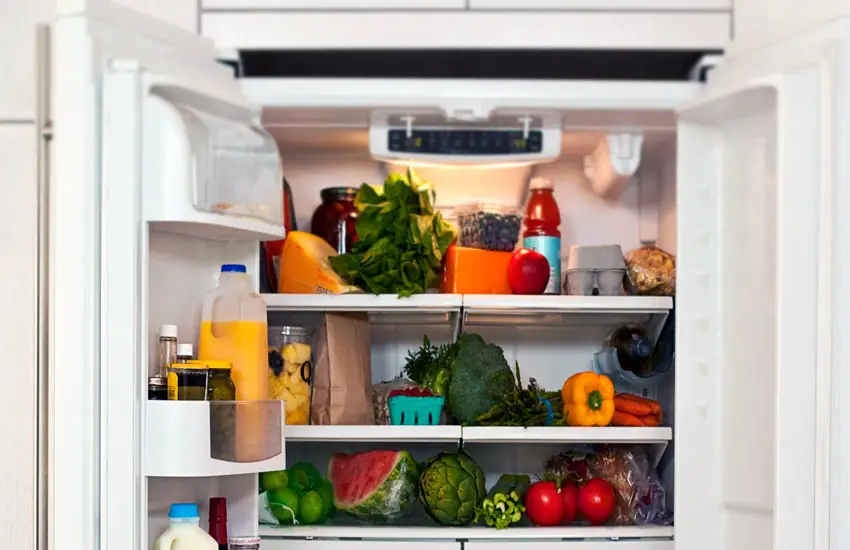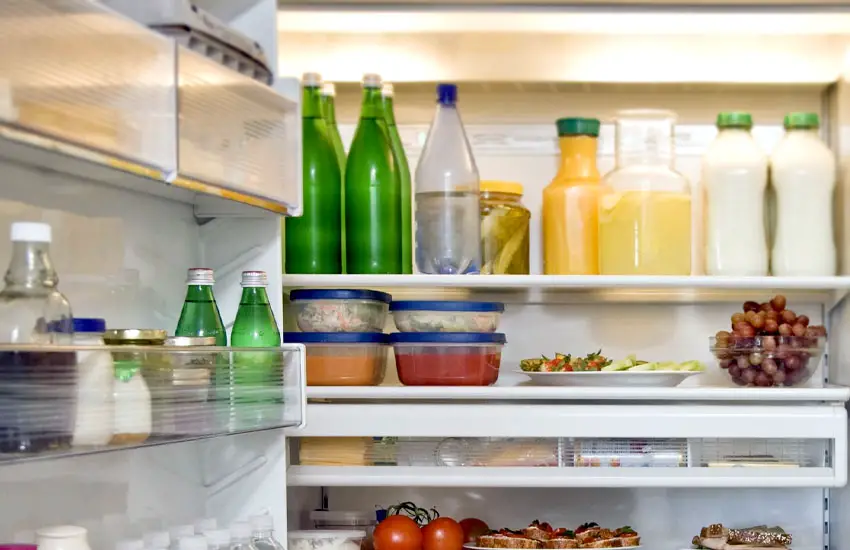As an Amazon Associate, I earn from qualifying purchases at no extra cost to you.
Samsung Refrigerator Leaking Water Under Crisper Drawers? Fix It
Have you ever opened your Samsung refrigerator, only to find a small puddle of water lurking under the crisper drawers? If you have, you’re not alone! This is a surprisingly common problem that can lead to frustration. Don’t worry though – we’ve got your back. In this post, we’ll dive into the reasons behind water leakage, how to fix it, and some practical tips to prevent it in the future. So, let’s troubleshoot and get your fridge back to its best!
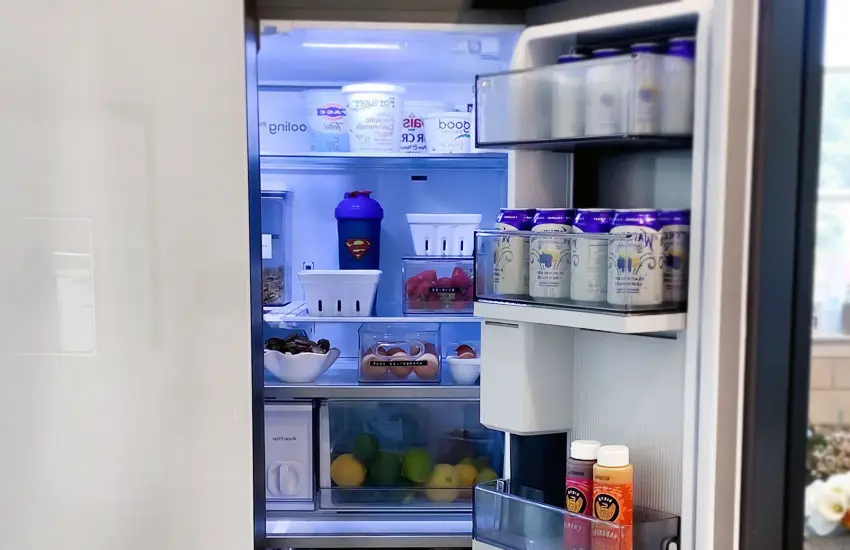
Common Causes of Water Leakage in Samsung Refrigerators
Water pooling under the crisper drawers is a familiar sight for many Samsung refrigerator owners. But, what’s the deal? Why is your fridge leaking water, and what can you do to stop it? Let’s explore the common causes behind this pesky issue.
1. Clogged Defrost Drain
One of the leading culprits of water leakage in many refrigerators, including Samsung models, is a clogged defrost drain. Your fridge goes through regular defrost cycles to prevent frost buildup in the freezer. During this process, the water from melting frost and ice flows down a defrost drain, which is usually located underneath the evaporator coils. If this drain becomes clogged with debris, ice, or food particles, the water has nowhere to go, and it starts to pool under the crisper drawers.
This issue is particularly common in older refrigerators, where the buildup of food crumbs or even mold can easily block the drain. In some cases, the defrost drain can also freeze over, blocking the flow of water. When this happens, the water begins to accumulate and leak into the fridge, which leads to the mess you’re seeing under the crisper drawers.
2. Broken Door Seals
If you notice water collecting under the crisper drawers only after opening and closing the refrigerator door, there could be an issue with the door seals. Over time, these seals can become worn, cracked, or damaged, allowing warm air from the kitchen to enter the fridge. This warm air causes moisture to accumulate inside the fridge, and some of it may drip down onto the crisper drawers, forming a small puddle. Not only can this lead to water leakage, but it can also affect the overall efficiency of the fridge, causing it to work harder to maintain the proper temperature.
Checking the door seals is easy. Simply press a piece of paper between the door and the fridge when it’s closed. If you can pull the paper out with little resistance, it’s a sign that the seal may be damaged and needs replacement.
3. Faulty Water Filter
If your Samsung refrigerator has a built-in water dispenser or ice maker, a faulty or improperly installed water filter can also lead to leaks. A loose or damaged water filter can allow water to escape into areas it shouldn’t be, leading to puddles and leaks. In some cases, water may drip from the filter area and trickle down under the crisper drawers.
To check if the water filter is causing the leak, make sure the filter is securely installed and in good condition. If you haven’t changed the filter in a while, replacing it with a fresh one may fix the issue. A regular filter replacement schedule is important not only for preventing leaks but also for keeping your water tasting fresh.
4. Blocked or Frozen Evaporator Coils
Evaporator coils inside your fridge are responsible for absorbing heat and keeping the temperature low. If these coils freeze up, either due to a lack of airflow or a malfunctioning thermostat, they may cause excess condensation. This condensation can accumulate under the crisper drawers and cause water to leak.
The evaporator coils can freeze due to various reasons such as improper air circulation or dirty coils. If the air vents inside the fridge are blocked by food items or if the thermostat is malfunctioning, it can lead to uneven cooling, causing moisture buildup.
5. Leaking Water Line to Ice Maker or Dispenser
If your refrigerator has an ice maker or water dispenser, the water line that feeds these features can sometimes develop leaks. A cracked or loose water line can lead to water pooling under the crisper drawers. In this case, the source of the problem isn’t inside the refrigerator itself, but rather in the plumbing that delivers water to the appliance.
You can check for this issue by inspecting the water line for visible cracks, kinks, or signs of leakage. If you notice any problems, you may need to replace the water line or call in a professional technician to make the repair.
How to Fix Water Leakage Under the Crisper Drawers
Now that we know the common causes, let’s walk through how to fix the issue. Fixing the water leakage depends on the cause, but we’ll go over the most common solutions to help you get your Samsung refrigerator back to working order.
Step 1: Unclog the Defrost Drain
A clogged defrost drain is one of the most common reasons your Samsung fridge leaks water under the crisper drawers. The defrost drain carries the water from melting ice in the freezer to a pan underneath the fridge, where it evaporates. If this drain gets blocked, water will start to build up and spill into the fridge.
Here’s how to fix it:
Unplug the Fridge: Safety first! Unplug your refrigerator so you can work on it without worrying about any electrical risks. Turn off the power, and give yourself some peace of mind to get started.
Remove the Food and Absorb the Water: Take out any food from the fridge and freezer, especially around the crisper drawers. You don’t want to make a mess with the food. Use a towel or cloth to soak up any water that has already collected under the crisper drawers.
Locate the Defrost Drain: Now, look for the defrost drain. It is usually found near the back of the fridge, at the bottom, or beneath the evaporator coils. Depending on your Samsung model, it could be in different places, but it should be easy to spot.
Clear the Blockage: If you can see debris, like food particles, or mold near the drain, you’ll need to clear it out. You can use a turkey baster or a small funnel to flush hot water down the drain. The hot water will help loosen the clog and flush it through. If you have a blockage deep in the drain, try pushing it out carefully with a small tool like a flexible wire or pipe cleaner.
Check for Frozen Blockages: Sometimes the defrost drain can freeze over, especially if it’s in a cooler part of the fridge. If that’s the case, try pouring warm water down the drain to thaw the blockage. You can also use a hairdryer on low heat to carefully melt any ice in the drain.
Test the Drain: After you’ve cleared out the blockage, pour a bit of water into the drain again to see if it flows easily. If the water drains properly, you’ve successfully cleared the clog. If it still seems blocked, repeat the process or check for any deeper issues.
Plug the Fridge Back In: Once the drain is clear and everything is dry, plug the fridge back in and give it a few hours to make sure the leak is gone. If everything is working properly, no more water should be pooling under the crisper drawers.
Step 2: Replace or Repair the Door Seals
The door seals are what keep the cold air inside your fridge and prevent warm air from sneaking in. When these seals are damaged, they allow moisture to build up inside the fridge, which can cause water to leak under the crisper drawers. A broken seal can also make your fridge work harder to stay cool, which can lead to other issues.
Here’s how you can replace or repair the seals:
Check the Seals: Open your fridge door and closely inspect the rubber seals around the edges. Look for any cracks, tears, or places where the seal might have come loose. You can test the door seal by placing a piece of paper between the seal and the fridge door. Close the door on the paper and pull it out. If the paper slides out too easily, the seal is likely damaged.
Order a New Seal: If you find that the door seal is damaged, it’s best to replace it. You can order replacement seals directly from Samsung or your refrigerator’s manufacturer. Make sure to get the right size and model for your fridge. If you’re unsure about the exact part, check your fridge’s manual or ask a professional.
Remove the Old Seal: To remove the old door seal, gently pull it away from the door frame. Most seals are held in place by a plastic track or groove. You can use a flathead screwdriver or a similar tool to carefully loosen and pull the seal out of the groove. Take your time and make sure you’re not damaging the fridge.
Clean the Door Frame: Before putting the new seal in, use a damp cloth to clean the door frame where the seal sits. This will ensure the new seal sticks properly and helps prevent any future gaps.
Install the New Seal: Start by fitting the new door seal into the groove along the door frame. Carefully press it into place, making sure it fits snugly all the way around the door. If the new seal comes with a track, make sure it’s aligned properly before pushing it in fully. Double-check that there are no gaps or areas where the seal isn’t sitting correctly.
Test the Seal: After the new seal is installed, close the door and check that it’s tightly sealed. You can use the paper test again to see if any air or moisture is sneaking through. If the paper stays stuck when you try to pull it out, the seal is working correctly.
Monitor for Leaks: Keep an eye on the fridge for the next few days to make sure that no water leaks underneath the crisper drawers. A good door seal should stop any moisture from building up inside the fridge.
Step 3: Check and Replace the Water Filter
If your Samsung fridge has a water dispenser or ice maker, a faulty water filter can be a source of leaks. Water filters are designed to keep your drinking water clean, but when they are not properly installed or damaged, they can leak and cause water to pool inside the fridge.
Here’s how to check and replace the water filter:
Locate the Water Filter: First, find the location of the water filter in your fridge. Most Samsung refrigerators have their filters either in the upper right-hand corner of the fridge or in the fresh food compartment. You may need to open a compartment to access it.
Remove the Water Filter: If you’ve never replaced the water filter before, you may need to consult the owner’s manual to find the exact steps for removal. Typically, water filters are easy to remove by twisting or pulling them out. Carefully remove the filter and set it aside.
Inspect the Filter: Once you remove the filter, inspect it for any signs of damage, cracks, or leaks. A damaged filter may leak water, especially if it’s not installed properly. If the filter is dirty, it may also be affecting water flow, which can cause leaks. If you notice any damage, it’s time to replace the filter.
Replace the Filter: Purchase a new water filter that’s compatible with your Samsung refrigerator. When installing the new filter, make sure it fits snugly into place and is securely locked into position. Don’t force it in – it should slide in easily if it’s the right fit.
Turn on the Water Supply: Once the new filter is in place, turn the water supply back on and check for any leaks around the filter area. If you notice any water dripping, double-check that the filter is seated correctly.
Flush the Filter: After installing the new filter, it’s a good idea to run some water through the dispenser or ice maker to flush out any air or loose particles. This will help ensure that the filter is working properly.
Test for Leaks: After everything is set up, monitor the fridge for the next few days to make sure no water is leaking from the filter area.
Step 4: Defrost and Clean the Evaporator Coils
Frozen evaporator coils can also lead to water leakage under the crisper drawers. When the coils freeze, they cause condensation, which builds up and spills out of the fridge. You can fix this problem by defrosting the coils and cleaning them.
Here’s what to do:
Turn Off the Fridge: Unplug the fridge to ensure your safety while working on it. Allow it to defrost naturally or use a hairdryer to gently melt the ice on the coils.
Remove the Food: Take out all the food from the fridge and freezer to avoid any spoilage while the fridge is off.
Defrost the Coils: If there’s a lot of ice buildup, you can use a hairdryer set to low heat to defrost the evaporator coils. Hold the hairdryer a safe distance away from the coils to prevent any water or electrical issues. You can also leave the fridge unplugged for a few hours to let the ice melt naturally.
Clean the Coils: Once the coils are thawed, use a soft brush or vacuum cleaner to remove any dust or debris that may have accumulated on the coils. This will help improve airflow and prevent the coils from freezing again.
Reconnect the Fridge: After cleaning and defrosting the coils, plug the fridge back in. Monitor the temperature to make sure it’s cooling correctly. The leak should stop if the coils were the cause.
Step 5: Inspect the Water Line
If your Samsung fridge has an ice maker or water dispenser, a leaking water line can also lead to water pooling under the crisper drawers. Here’s how to fix it:
Test for Leaks: Once the new water line is connected, turn the water supply back on and check for any leaks around the water line area.
Turn Off the Water Supply: Before you start working, turn off the water supply to the fridge. This will prevent water from leaking as you inspect the water line.
Check the Water Line: Look for any visible cracks, kinks, or leaks in the water line. The water line is usually a plastic or metal tube running from the back of the fridge to the water dispenser or ice maker.
Replace the Water Line: If you find a crack or damage, you may need to replace the water line. Turn off the water supply, disconnect the line, and remove the old one. Then, attach a new line and reconnect it to the fridge and water supply.
With these steps, you should be able to fix most common causes of water leakage under the crisper drawers in your Samsung fridge!
Preventing Future Water Leakage in Your Samsung Refrigerator
Once you’ve fixed the current issue, it’s a good idea to take preventive measures to avoid any future water leakage. Here are some tips to keep your Samsung refrigerator working smoothly:
1. Regularly Clean the Defrost Drain
Keep the defrost drain clean and free from blockages by flushing it with hot water every few months. This will prevent water from backing up into the fridge.
2. Inspect Door Seals Periodically
Inspect the door seals every few months to ensure they are in good condition. If you notice any damage, replace them right away to prevent warm air from entering the fridge.
3. Replace Water Filters on Time
Make it a habit to replace your water filter every six months or as recommended by the manufacturer. This will help maintain the performance of your water dispenser and ice maker and prevent leaks.
4. Keep the Freezer Vent Area Clear
Ensure that the freezer vents are not obstructed by food items. Proper airflow is essential for the fridge to function efficiently and prevent condensation buildup.
By following these simple maintenance steps, you can avoid future water leakage issues and extend the lifespan of your Samsung refrigerator.
I hope this guide has helped you understand the common causes of water leakage under the crisper drawers in your Samsung refrigerator and provided you with clear solutions to fix it. With a little care and attention, you can ensure that your fridge stays in top condition and avoids unnecessary water leaks. Remember, regular maintenance and inspections go a long way in preventing these types of issues.
Frequently Asked Questions
Is it normal for a Samsung refrigerator to leak water under the crisper drawers?
While it’s not typical for a Samsung refrigerator to leak water under the crisper drawers, it can happen due to issues like clogged defrost drains or damaged door seals. It’s a good idea to troubleshoot and address the root cause.
Can a clogged defrost drain cause water leakage?
Yes, a clogged defrost drain can block water flow, causing it to pool under the crisper drawers. Regularly cleaning the defrost drain can prevent this issue.
Do I need to call a professional if my refrigerator leaks water?
You can try fixing the issue yourself by following the steps in this guide. However, if the problem persists or if you’re unsure about handling repairs, calling a professional technician is always a good idea.
Is there a way to prevent water leakage from the ice maker?
To prevent water leakage from the ice maker, make sure the water line is securely connected and that the filter is in good condition. If you notice any leaks, check the water line for damage.
Can a broken water filter cause water leakage under the crisper drawers?
Yes, if the water filter is damaged or improperly installed, it can lead to water leakage inside the fridge, including under the crisper drawers. Make sure to replace the filter regularly.
Is it possible for evaporator coils to freeze and cause water leaks?
Yes, frozen evaporator coils can cause condensation to build up, which may leak onto the fridge floor. Ensure proper air circulation and clean the coils periodically to avoid freezing.
Can a faulty door seal lead to water leakage under the crisper drawers?
Yes, if the door seal is damaged, warm air can enter the fridge, causing moisture buildup inside, which may drip down onto the crisper drawers. Replace damaged seals to prevent this issue.
Is it safe to use a hairdryer to defrost the coils?
Using a hairdryer can speed up the defrosting process, but make sure to keep the hairdryer at a safe distance from any water or electrical components. If you’re unsure, let the fridge defrost naturally.


